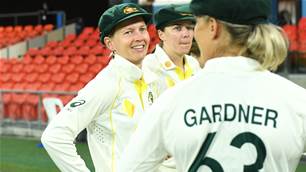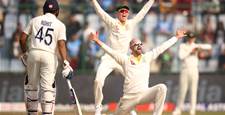Remember Deborah Acason? Remember the 2006 Commonwealth Games?
Remember Deborah Acason? Remember the 2006 Commonwealth Games?
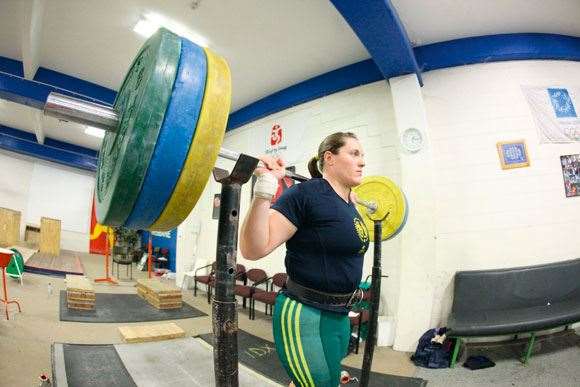 “Most lifters work on a 12-week cycle"
“Most lifters work on a 12-week cycle"Images: Warren Clarke
Back then, before she was married, she carried the apt surname of Lovely. Remember how, in front of the Melbourne crowd, she hoisted 115kg in the clean and jerk to bump Nauru’s Sheba Deiraragea into the silver? And remember how, with 115kg of quivering iron balanced above her head, the gold medal in the bag, she threw the bar to the ground in an explosion of joy? Remember how she leapt and danced and shrieked her way off the platform?Well, don’t forget her. In a few month’s time she could well be leaping-dancing-shrieking her way off the Delhi platform with another gold medal …
The weighting game
“My coach, Mike Keelan, and I have always viewed my training program as a prescription. The thinking is: this is basically what I have to do, but see how I feel and change it as I see fit. I think Mike has had a pretty stressful eight years with me because he’s always had to chop and change things.
“At the ‘06 Commonwealth Games I was in the 75kg class – since then I’ve moved into the over 75kg class. With weightlifting you have to weigh-in two hours before you compete so when we drop bodyweight we have to make sure we do it properly, through diet and training, not just sweating it out in the sauna. It’s not like boxing where you weigh-in the day before.
“When I was of a lighter bodyweight I was doing more training. I was training eight-to-ten sessions a week, probably an hour and a half to two hours each session. Moving into a heavier bodyweight class, I’ve really had to cut back my training. When I was weighing 78kg, I was doing about 1000 repetitions a week. Now that I’m 88-90kg, I’m only doing about 300-400 repetitions a week, because I’m lifting heavier weights and need more time to recover.”
Like a yoyo
“When I started lifting, as a 17-year-old, I weighed 80kg. At that stage I was very much a teenager – a little bit soft muscle-wise. I decided I wanted to drop a weight category – mainly for appearance – so I was careful with my diet, burnt a huge amount of calories in training and had no problems dropping into that 75kg category. But as I got stronger I pushed more weight, developed more muscle tone and I struggled to stay in that weight class. An exercise physiologist put me through a series of tests which indicated that my absolute leanest weight, given my muscle mass, was around 78kg. So for me to drop beneath 75kg was getting pretty difficult.
“Before the ‘06 Commonwealth Games, Mike and I looked at the rankings, looked at who I’d be competing against and decided that I needed to move up a class. Having made that decision I very quickly moved up to 86kg. I still had a good diet [I’ve never liked junk food]; it was just muscle mass-centred with a very small increase in body fat.
“Then, a month out from the Commonwealth Games, a heap of competitors dropped out of the 75kg class [the defending gold medallist, India’s Pujari Shailaja, was disqualified after testing positive to stanozolol] and we suddenly realised that, while I might finish fourth or fifth in the heavier class, if I could drop beneath 75kg then I could possibly take gold or silver. So I had to drop 11kg – 15 percent of my bodyweight – in a month. A pretty big task! I cut right back on what I was eating. I had to figure out exactly what I needed for energy and not go beyond that. Initially I tried cutting out all carbs, but I quickly realised I just couldn’t operate on no carbs – I was still training two hours most days and I needed energy. I started having oats with milk in the morning, and I made sure I had some carbs after each session. I was also doing hour-long walks each morning and night. That helped burn a lot of calories.
“Yeah, I was hungry and it wasn’t a lot of fun, but the weight came off and I won gold … ”
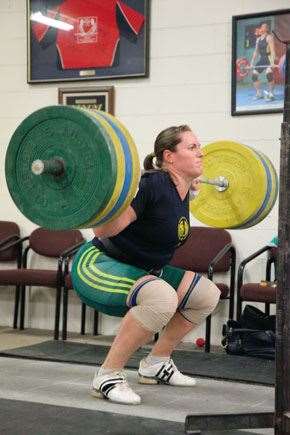 "if I could drop beneath 75kg then I could possibly take gold or silver."
"if I could drop beneath 75kg then I could possibly take gold or silver."Images: Warren Clarke
Gym time
“In a typical session I’ll have five exercises to work through. Two of those five will be technical lifts – a snatch and a clean and jerk. We tend to go heavy with our main technical exercise – generally the snatch. With the other technical exercise – the clean and jerk – the focus is more on power.
“After the technical exercises we’ll move into three strength exercises. Generally one of these will be squats – either front or back squats, occasionally half-squats. Another typical strength exercise is heavy snatch pulls. When I was snatching 113kg, for example, I was doing snatch pulls of about 120-125kg, just so I could feel that heavier weight off the ground. From there we’ll often move to Romanian deadlifts, working our gluts and hammies. After that we’ll normally do heavy shrugs. When I was clean and jerking 140kg, for example, I was shrugging up to 220kg.
“When I was lighter I would typically do more repetitions in my sessions. If I wasn’t carrying injuries I would’ve been looking at, say, five-to-six reps with my strength exercises. Now, I’m normally looking at doing threes, twos and ones
– particularly with the technical lifts, because they take so much out of my body. All up, I’ll normally do somewhere between 15-20 reps for each of those five exercises. I’ll have around a minute’s recovery between each set – although sometimes I like to take a little bit longer … ”
In the cycle
“Most lifters work on a 12-week cycle. Some prefer the 18-week cycle, but personally I would just get injured over 18 weeks because I go pretty hard in my training. In the first month I’m looking at doing a lot of strength work. I’m
at the start of a cycle working towards Delhi at the moment, so I’m doing three or four pull and squat exercises and only one technique exercise. I’m pushing between 70-85 percent of my maximum in this month.
“For the second month the ratio levels-out to about 50 percent strength and 50 percent technique. I’ll normally do a snatch or a power clean or a jerk, then team that with a squat or a pull or a shrug. In this month I’ll be lifting around 85 percent of my maximum on the technical lifts, and close to 90 percent on the strength lifts. I’m looking at around three reps per set here.
“In that last month you only have three weeks of training – the last hit-out in the gym is generally eight days before competition. In that last session I’ll be pushing pretty close to my maximums. The strength component is down
to about 30 percent of our workload for this month, while the technical stuff is up around 70 percent. Reps are down to doubles and even singles. I’ll try to mix-up my technical lifts at this point – doing, say, snatches on Mondays, clean and jerks on Wednesdays and power snatches on Thursdays – just so I don’t feel like I’m doing the same thing over and over.”
Mind power
“When it comes to competition, I normally take the weight I lifted in that last training session, add 5kg, and that’s what I’ll attempt on the platform. This approach is quite different to some of the other lifters who lift more in training, then hope to match that on the platform. Personally, when I’m on the platform, the adrenaline flowing, that’s when I pull out the big weights.
“You have to have a coach who knows when you can pull out the big weights. You don’t want a situation where you’re struggling in your warm-up lifts and your coach is freaking out, thinking, ‘Oh my goodness, if 90 looks hard here, she’s not going to lift 92 on the platform!’ Psychology is so important with lifting. You’ve only got three attempts – if you miss your lifts you’ve got nothing.
“I’ve been so lucky to have Mike. I remember one competition where I started on 87kg – a pretty high starting weight given that my best lift at that point was 90kg. I missed my first lift – I was mucking around and it was a silly miss. I went back out and missed again, exactly the same, another stupid miss. I was so frustrated. On my third lift, instead of making me lift 87 again, Mike put 95kg on the bar. That was 5kg above my best! Everyone thought, ‘What is this coach doing? This is absolutely ridiculous ... ’ But when I got out there I was so frustrated, so aggressive, the 95kg just flew up. That’s the psychology a coach needs to impart – get out there, I know you can lift this.”
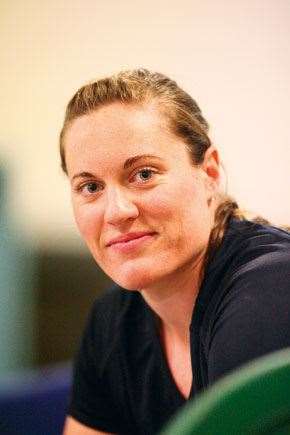 Deborah Acason Portrait
Deborah Acason PortraitImages: Warren Clarke
Supple joints
“When I came to lifting, as a 15-year-old, I was already very flexible from my training as a discus thrower. I was lucky. A lot of people come to lifting and they’re very tight through their hips and gluts. If you’re tight in those places you can’t do full squats – and that’s a bit of problem. With our stretching we start from the legs and move up – the hammies, the quads, the gluts, the hip flexors and a lot of ITB [iliotibial band] stretches.
“A lot of people – particularly bodybuilding guys who’ve done a lot of bench press – come to weightlifting and find their shoulders are too tight to hold the bar overhead. These guys really have to work on their shoulder flexibility. I actually had the opposite problem – I got a shoulder injury at the Beijing Olympics because my shoulders were too flexible. Imagine you’re at the bottom of a lift holding 125kg overhead – it’s not good to have loose shoulders! After that injury my doctor told me to stop doing shoulder stretching to allow my shoulder muscles to tighten up. Ideally we’d stretch for 20 minutes before and after each gym session.
“Lately, a lot of research has said there’s no point stretching before exercise, but in our sport some people can’t physically get their bodies into the full squat position unless they stretch. For us it’s actually facilitative stretching – allowing us to get into position.”
Core values
“When I was 18 years old and training for the 2002 Commonwealth Games in Manchester, I discovered that every time I lifted from the squat position, my back was slightly rounded. I didn’t realise I was doing this, and of course I ended up with a bulging disc in my back. My doctor told me I had to do a huge amount of core work or that would be the end of my lifting career. And I thought, ‘Okay, better take this seriously … ’
“For three months after that I did nothing but abdominal bridges; holding that plank position. When I started I could only hold 20 seconds on the front and seven seconds either side. I started doing about 10-to-20 of these bridges a day, mainly because it was the only exercise that didn’t hurt my back. After a month I was able to hold for about two or three minutes. After three months I was holding these bridges for a minute with 100kg on my back.
“If I have a week or two off now, I feel my abs are the first thing to go. When I come back to the gym – if I’ve weakened in the core – my technique’s terrible, so I do a huge amount of core work.”
Cool down
“We’ve got a sauna at our gym, which is helpful. I feel a sauna after a session really gets rid of the lactic acid. Of course it’s also psychological – it’s nice to have a rest after you train. We have plunge bins that we fill with ice and jump into after the sauna. I tend to feel a bit lethargic after the sauna, so that freezing water wakes me up a bit. When I’m in heavy training I also try to get strong massages at least once a week. The amount of muscle knots I get doing weights over and over is quite incredible, so massages really help.
“I’m not sure if you’d call this recovery, but I’m studying at the moment [a double degree in Law and Criminology at Griffith University]. It’s a good thing to have something else to focus on besides your sport. I honestly don’t think I would’ve got to this level if it weren’t for my study. My brain has to be engaged by something else, otherwise I’d just think about my sport the whole time and that’s not the healthiest thing in the world.”
– Aaron Scott
Related Articles
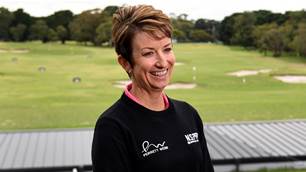
Karrie calls for ‘more positive messages’ in golf

Golf added to Commonwealth games for 2026
